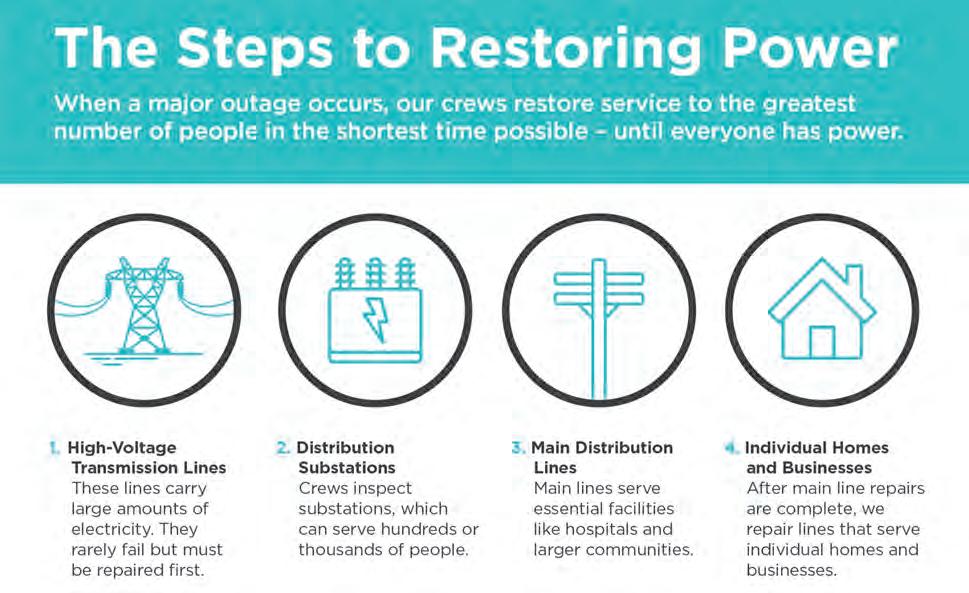
4 minute read
Carolina Gardens
from 2022-09-SREMC
Weatherization and insulation improvements can help improve comfort and costs.
A little home improvement, like weatherizing with caulk and weather stripping, is only part of the equation. Caulk is for non-moving pieces like around plumbing penetrations and window sills, while weather stripping is for moving pieces, like doors and windows.
The other part of that equation is insulation, and that should make you do some research. There are different kinds of insulation, and what type of insulation works best for space, what resistance value, or R-value, does your insulation need to have?
The R-value of insulation is a measure of the insulation's ability to resist heat. The higher the R-value, the greater its effectiveness.
You can help control the climate inside your home with the right insulation. Beyond attics and walls, imagine a home insulation solution that creates a snug “housing envelope” controlling heat, air, moisture and sound. Don’t forget garage door insulation, as well as other overlooked potential spots to control your indoor environment. Even the smallest gaps and cracks can be filled with spray-on insulation.
The type of house insulation you need depends on where you put it and if you need to control moisture. Keep your space dry with faced insulation, which uses a sheet of paper to control moisture vapor between walls and floors. Unfaced installation doesn’t have a paper moisture shield. It’s often used over existing insulation in the attic, where moisture control isn’t needed.
Spray foam insulation could be considered to fill cavities, gaps, cracks, expansion joints and other sources of air leaks. Rolling out batts of insulation
It helps resist moisture that can lead to mold or mildew and provides increased sound and thermal insulation.
Rolls are easy to transport and can be cut to the length you need. Use these to cover large areas. Batts come in pre-cut lengths, which makes installation fast and easy, especially for framed spaces. These insulation panels also provide excellent noise control.
Tip: Batt insulation packages contain more square feet than rolls. Blown-In insulation is installed using blowing machines. It makes adding insulation to your attic a breeze.
South River EMC offers rebates on insulation and weatherization improvements, and details can be found at sremc.com/ insulation-weatherization or by calling 910.892.8071 x 2222.

Attic with spray foam insulation
South River EMC Communicator
PO Box 931 Dunn, NC 28335 910.892.8071 800.338.5530 sremc.com
4 Methods to Make Your Own Unique Soap

Create handcrafted soaps for yourself or gift them to a friend
By Rue Reynold
Soapmaking can be a rewarding hobby to get into for gift-giving or a personal treat. To help get you started, here are four methods to create the soap of your dreams.
Melt and pour The melt and pour method is the easiest way to make soap. You buy a premade soap base, melt it down and then add color, fragrance or oil. Once it hardens, it’s ready to use. This is a great method for absolute beginners, children and those who are hesitant to work with lye (the solution used to make soap from scratch).
Cold process The cold process is the most common method for hobbyists because you have complete control over what goes in your soap and how it looks. This is a made-from-scratch process that’s done by mixing fats (oils and butters), sodium hydroxide lye, fragrance or color. Combining fats with lye begins a chemical reaction called saponification which breaks down the fats for them to bind with the lye. After setting the soap mixture aside, saponification and water evaporation can take up to 30 days or more for handmade soap to dry and reach its maximum mild state. Always be in a well-ventilated room and wear protective goggles and gloves when working with lye, which is a strong chemical that can burn skin or cause harm if the fumes are inhaled.
Hot process This method mirrors the cold process almost exactly, but rather than wait for saponification to complete on its own, you significantly speed it up by applying heat. While hot processed soap should also be allowed to set before using, it takes much less time to complete compared to cold processed soap. The downside to this method is not being able to easily design elaborate patterns. To learn more about hot process soapmaking, check out “Hot Process Soap Making” by Heidi Villegas. Milling Also known as French milling or hand milling, this method combines cold process, hot process and melt and pour. Soap is first made using either the cold process or hot process method. Once complete, the soap is grated and then melted as you add additional color, fragrances or ingredients.
Milling is often alternated with the term “rebatching” because they follow the same process, but they have different meanings. “Milling” indicates creating your own soap starting from the cold process or hot process method. “Rebatching” refers to reshaping an old soap, taking a premade commercial soap and adding your own spin to it, or fixing a soap that may not have gone as planned during the original cold process or hot process attempt.
No matter which method you choose, research and prepare thoroughly before attempting to make soap. Take each step one at a time and you’ll soon have a shelf (and gift bag) full of amazing handcrafted creations.
Rue Reynold is the editorial assistant for Carolina Country.








